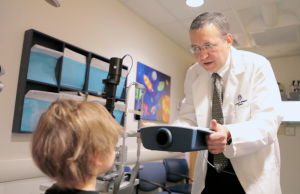
Valentine's Day is Innovation Day (image: Richard Giles/Flickr)
In a series of 17 short TED-style talks next Tuesday, February 14, clinicians and scientists from Children’s will present new products, processes and technologies to make health care safer, better and less expensive. The event, from 1-5 p.m. Eastern, is sponsored by the Innovation Acceleration Program. It’s now running a wait list, but you can also watch the live stream or track the proceedings on Twitter (#iDay) or via @science4care. Here’s a small sampling of next week’s presenters; for details, read the press release or view the full agenda.
Diagnosing lazy eye when it’s most treatable: in preschoolers
If lazy eye, or amblyopia, is caught early – ideally, before age 5 – it’s easily treated by patching the “good” eye, forcing the child to use and strengthen the weaker eye. But if it goes unnoticed, the weak, unused eye can slowly go blind, Full story »

Hunter hopes to make amblyopia screening routine for all preschoolers.
Children with “lazy eye,” or amblyopia, have structurally intact eyes that may appear normal. But one eye isn’t used, generally because of a subtle misalignment. Unless someone notices this early enough, the “lazy” eye can slowly go blind, simply because the brain hasn’t received proper stimulation from it. It’s learned to ignore input from that eye.
“While amblyopia is easy to treat if you get to the kids early, it’s hard for us as ophthalmologists to get to the kids early because often the condition isn’t detected in the pediatric office,” says David Hunter, chief of ophthalmology at Children’s Hospital Boston.
Treatment consists of patching the sound eye, forcing the child to use the weaker eye. Ideally, this should be started before age 5, when the brain is still able to relearn; once a child reaches 8 to 10 years it’s often too late to restore his vision. Full story »









